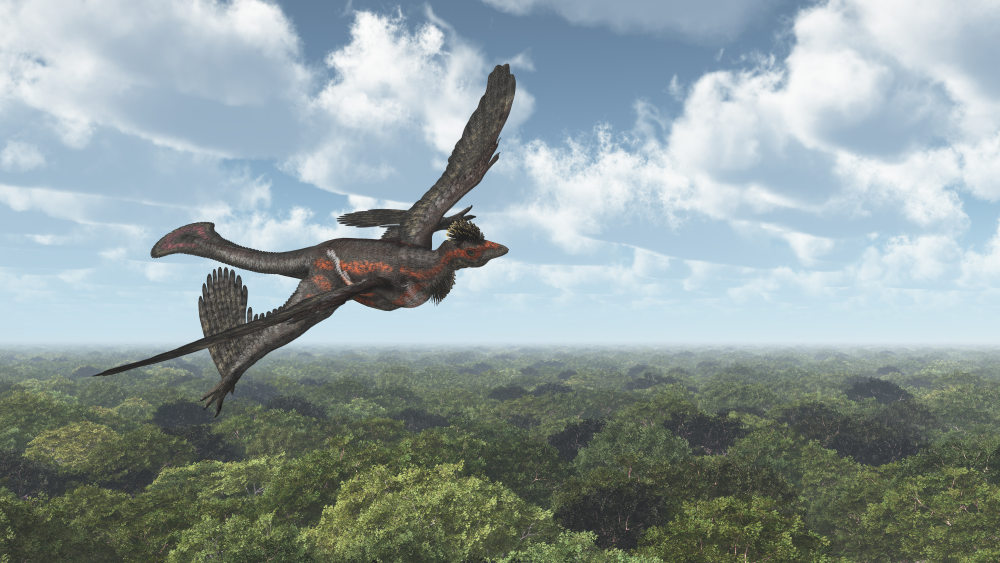Around 125 million years ago, a small dromaeosaurid dinosaur started moving around the Earth. Not all that surprising given it was the start of the Cretaceous, the last period of the Mesozoic that we know as the “Age Of Dinosaurs” – that is, until you find out it had four wings. And yes, it was a dinosaur, not a flying reptile.
Meet Microraptor, a genus of “small thieves” if you break down their name into the Greek and Latin meanings. However, unlike its larger relative velociraptor, Dr David Hone of Queen Mary University of London suspects the nickname has more to do with its family tree than its predatory prowess.
“That’s more a kind of quirk of etymology,” Dr Hone told IFLScience. “Lots of Dromaeosaurs end in ‘raptor’ and, when it was found, Microraptor was the smallest of them. It was predatory, but I think the etymology is more trying to get to the point that this is a small Dromaeosaur than it’s a vicious little hunter.”
The predation tactics of Microraptor are something Hone is familiar with having only recently published a paper that marked the earliest known evidence of a dinosaur eating a mammal. The star specimen was a Microraptor that in life would’ve been about the size of a crow, and it went into the fossil record still carrying the foot of a mouse-sized ancient mammal tucked inside its ribcage.
If it was a bird specialist, I’d just be gobsmacked, because birds fly way better than this thing. It would be like using helicopters to catch jets.
Dr David Hone
Despite getting less press attention than other Dromaeosaurs – we’re looking at you, Velociraptor – we actually have considerably more fossils of Microraptor, some with incredible detail, including feathers, and quite a few with preserved stomach contents. This has enabled us to build a more accurate picture of their skills, limitations, and dietary preferences (or – as their stomach contents indicate – the lack thereof).
“One [specimen] has a mammal, one has a fish, one has a lizard, and one has a bird, and so what that really tells you is they’re probably a generalist,” said Hone, who likens them to an urban fox, basically eating anything smallish they can sink their teeth into. “If it was a fish specialist, we’d see fish-catching adaptations, and those are quite distinctive. If it was a bird specialist, I’d just be gobsmacked, because birds fly way better than this thing. It would be like using helicopters to catch jets.”

The front and rear wings had different feather types, indicating they probably had different functions.
Image credit: Michael Rosskothen, Shutterstock.com
The fearsome reputation of dinosaurs makes it difficult to imagine them doing anything badly (except for Carnotaurus, that lovable fool), but as Hone highlighted, it’s a common misconception that evolution is always refining the best possible version of something. Constant trade-offs mean that not every trait of an animal is always the most useful in every scenario, and in the case of Microraptor, developing an extra set of wings might’ve held it back in other areas.
“They might be trying to use their legs to help them steer, but they still need to walk on them and they still need to grab prey with them. Their arms might be specialised for flying, but they still need to hold on to stuff – quite probably both prey and things like trees – and you almost certainly can’t build a wing that gives you the best possible lift and is good for grabbing things. You just can’t.”
It’s like us doing the splits; we can just about, but it’s not a normal thing, and it’s really not a thing for dinosaurs.
Dr David Hone
So how did it fly with all that wing going on? Well, at one point, the running theory was that it moved through the air sort of like a biplane. Imagine a spatchcocked chicken gliding through the air and you’re halfway there, but as Hone pointed out, the hips don’t lie.
“That’s probably not the case, because the hip socket just doesn’t really go sideways like that. It’s like us doing the splits; we can just about, but it’s not a normal thing, and it’s really not a thing for dinosaurs.”
So, if we scratch spatchcocked dinosaurs off the list, what’s left? The current thinking is it’s more likely Microraptor flew using its forewings for lift, and its rear wings for steering – sort of like how modern eagles have their legs dangling down during flight. As Michael Habib and Justin Hall of the University of Southern California told The Economist, doing this with a few feathers to boot could treble the speed of a turn and reduce the radius of its turning circle by 40 percent.
Pretty good for animals that hunted through the forest, but it seems, not good enough. Extra feathers means paying drag tax, an energetic expense that two-winged birds don’t have to grapple with, which may explain why chickens are still being spatchcocked today while Microraptor will forever remain an awkward biplane stamped into the fossil record.
RIP Microraptor, you would’ve loved the Varibike.
Source Link: Microraptor Was A Four-Winged Dinosaur That Probably Should've Stopped At Two